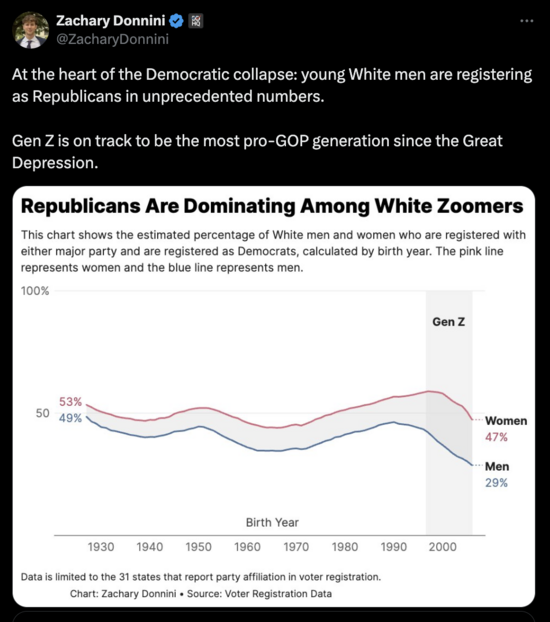It’s been a bleak 4 years for Democrats among young voters—especially white men. This isn’t the first time we’ve had this problem, and it certainly won’t be the last.
In the 2024 election, President Donald Trump carried the vote among men overall by 12 points, even as Vice President Kamala Harris led women by 8 points. Married men gave Trump a lopsided 60-38 advantage, and he even edged out Harris among Latino men with 54-44. And while just 1 in 5 Black men backed Trump, that still contrasted sharply with Black women, who went 92-7 for Harris.
But the most alarming numbers came from young voters. Men under 30 narrowly broke for Trump at 49-48, while women the same age supported Harris by a commanding 61-38. This reversed decades of younger generations voting almost uniformly more liberal than preceding ones.
But in hindsight, none of this should have been surprising.
Long before votes were cast, party registration data showed where things were heading. In 2018, Democrats accounted for 66% of new voters under 45 who registered with a major party. By 2024, that cratered to 48%, which was reflected in the election results.
This chart illustrates just how stark that decline has been:

The collapse didn’t come out of nowhere; it unfolded under very specific conditions. The coronavirus pandemic wrecked the high school and college experiences of millions of young people. Inflation and a shaky post-COVID economy hammered those at the lower end of the ladder—young workers most of all.
At the same time, the “manosphere” exploded, with right-wing podcasters—like Trump’s favorite, Joe Rogan—building massive audiences. Add in a cultural backlash against patriarchy—which then triggered a counter backlash—and the ground was fertile for grievance politics.
Future prospects looked just as grim. Skyrocketing tuition made college feel like a luxury, while housing prices made home ownership a fantasy for most. Against that backdrop, disillusionment was inevitable.
I previously covered this study by Equimundo, which works to engage young men as allies for gender equality. It found that economic precarity collides directly with traditional notions of masculinity, particularly the expectation that men must be providers. When that role is out of reach, it produces despair, rage, and attraction to authoritarian strongmen. In other words, when society tells men their value is tied to their ability to provide, but the economy makes that impossible, the door opens wide for Trumpist fantasies.
But here’s the thing: most of these young men have not experienced a Republican presidency as adults. George W. Bush’s failures were before their time, and they only knew Trump as the bombastic entertainer lobbing bombs at all the same people that they hate.
Now reality has hit, and a blockbuster Pew poll showed Trump’s approval among his 18- to 34-year-old supporters collapsing from 94% in February to just 69% by the first week of August.
That drop is common sense. While older Trump voters knew exactly what they were buying, younger ones were in for a cruel surprise. And the pain isn’t over. Trump’s tariffs haven’t yet fully rippled through the economy, nor have his other destructive policies—from mass deportations that gut cheap immigrant labor to his scheme to politicize the Federal Reserve.
More damage is coming.
But none of this erases the Democratic Party’s core problem with men: a battered brand, terrible voter registration numbers, and a tendency to talk about men in ways that feel more like scolding than persuasion. And, yes, I include myself in that.
But Trump’s rapid loss of support among young men might give us all some breathing room heading into the 2026 midterms—not to mention a chance to start repairing relationships with a group that is politically adrift.
Conventional wisdom in political science says partisan loyalty locks in after 2 consecutive elections with the same party. This cohort already went with Trump once, but their new wariness—fueled by lived experience and even reflected in doubts from figures like Rogan—suggests that Democrats might have an opening.
The challenge is whether the party is willing to take it.
